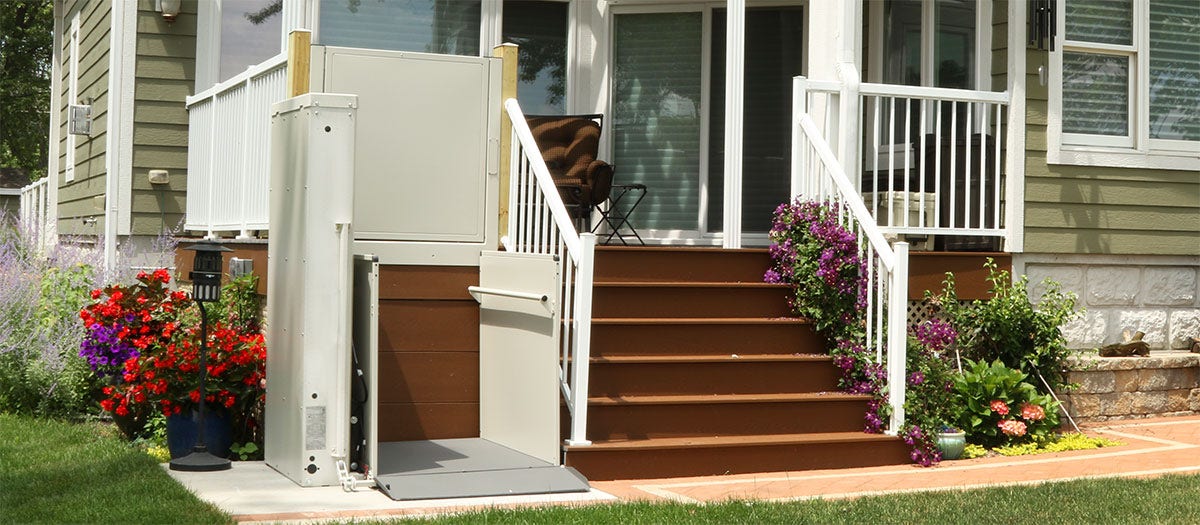
Wheelchair Ramp Slope: Your Own ADA Compliant Ramp
Are you looking to build your own ramp but want to make sure it is safe? Good! Every wheelchair ramp should be safe.In fact, there are ADA guidelines to make sure that wheelchairs, ramps, and pathways are safe.
One of the largest safety measures concerns the wheelchair ramp slope. Keep reading to learn more about this critical measurement.
Understanding Slope
A lot of planning goes into wheelchair ramp design. They need to provide enough space and clearance for the chair to move up the ramp and around corners. They need to ensure that the transition between the ramp and the landing is smooth.
They also need to provide a manageable slope. If you remember your algebra, slope is expressed as a ratio of rise to run. For example, a ramp that sits five inches high (rise) and is fives inches long (run) has a 5:5 slope.
Slope can also be expressed as a percentage: X units of rise per 100 units of run. For example, a 36-inch rise over a length of 100 inches is a 36 percent slope.
Slope can also be expressed in degrees, a measurement of the inverse tangent of the rise divided by the run relative to horizontal.
Let's keep this easy and mostly talk about simple ratios for ramp slopes.
Calculating ADA Ramp Slope
In truth, there is not much to calculate. The ADA provides good direction about ratios for wheelchair ramp slopes.
The commercial and public facility standard for slope is 1:12 (in inches) or about 5 degrees of incline.
For those building ramps at home, the ratio can be as steep as 3:12 or almost 15 degrees. This is useful is space is really limited, however it can be difficult for motorized wheelchairs and powered scooters.
What is The Proper Wheelchair Ramp Slope Measurement?
The happy medium for ramps at home is a ratio of 2:12 or about 10 degrees of incline.
A 2:12 ratio gives is not too challenging for wheelchair users and cuts the length of a potential ramp in half.
For example, at a 1:12 ratio, a ramp that sits 36 inches high is then 36 feet long. It is 18 feet long at a 2:12 ratio.
If this is too complex, you can use a ramp slope calculator.
The Effect on Ramp Design
The implications of calculating slope have a significant effect on ramp design for a handicap accessible house. Not every wheelchair ramp can fit on a straight run.
This is because there is no set standard for the height of a home's landing. A wheelchair ramp slope might have to reach a 24-inch height, it might have to reach a 44-inch height.
Every home is different. Building your ramp is a unique project.
Ramps also need to be easy to access from the ground and provide adequate space at the landing. Many at-home wheelchair ramps use an angled or switchback design.
ADA Ramp Requirements
The ADA also limits commercial and public ramps to a maximum run of 30 feet before a rest or turn platform.
If you need a ramp for your home, a qualified contractor or manufacturer will be able to design an ADA-compliant ramp for you. And if this article helped you understand the wheelchair ramp slope, keep reading our blog for more.
Other Questions You May Have About Handicap Ramp Slope
What is the proper slope for a ramp?
1:12 Slope
Max Slope for ADA ramp: What is the maximum gradient for a wheelchair ramp?
The ramp must have a 1:12 slope ratio. This means that there must be a one-inch rise in the ramp for every corresponding 12 inches of the ramp.
How wide is a wheelchair ramp?
Ramps over 30 feet in length create hazards and offer no space to rest or remain neutral. Platforms should be put in every 30 feet at a minimum and be 5 feet by 5 feet to offer a comfortable area to rest on.
How to calculate ramp slope percentage?
Calculating the ramp slope percentage is crucial when designing a wheelchair accessible ramp because it directly affects the ramp's usability and safety for individuals using wheelchairs or other mobility aids. The slope percentage indicates the steepness of the ramp and determines how easily a wheelchair user can ascend or descend the ramp. The recommended slope for wheelchair ramps is 1:12 (one inch of rise for every 12 inches of ramp length). For example, if the deck's height is 24 inches, the ramp length should be approximately 24 feet to achieve a 1:12 slope. Adjust the calculations based on your specific requirements.
To calculate the ramp slope percentage, you need to know the rise (vertical height) and the run (horizontal length) of the ramp. The formula to calculate slope percentage is: Slope Percentage = (Rise / Run) x 100
Here's a step-by-step guide on how to calculate the ramp slope percentage:
- Measure the Rise: Measure the vertical height between the starting point (e.g., ground level) and the endpoint of the ramp (e.g., the top of a deck or platform). Make sure to measure the vertical rise in inches or centimeters.
- Measure the Run: Measure the horizontal length of the ramp, which is the distance between the starting and ending points of the ramp. Measure the horizontal run in feet or meters.
- Plug in the Values: Using the formula mentioned above, divide the rise by the run and multiply the result by 100 to obtain the slope percentage. Make sure to perform the division before multiplying by 100.
For example, let's say the rise of the ramp is 24 inches, and the run is 240 inches (20 feet):
Slope Percentage = (24 inches / 240 inches) x 100
= 0.1 x 100
= 10%
In this example, the calculated slope percentage is 10%.
Why is slope percentage important?
The slope percentage of a wheelchair accessible ramp is crucial for several reasons:
Accessibility: The slope percentage determines the ease of access for wheelchair users. Steeper slopes can be challenging for individuals to navigate, especially for those with limited upper body strength or mobility impairments.
Safety: A moderate slope percentage ensures safer use of the ramp. Steep ramps can increase the risk of a wheelchair tipping or rolling backward, posing hazards to users. A well-calculated slope percentage provides a stable and secure path.
Compliance with Regulations: Many building codes and accessibility guidelines, such as the Americans with Disabilities Act (ADA) in the United States, specify the maximum allowable slope percentage for wheelchair ramps. Compliance with these regulations ensures that ramps meet the necessary standards for accessibility.
By calculating the ramp slope percentage accurately and adhering to the recommended guidelines, you can create a wheelchair accessible ramp that offers safe and comfortable access for individuals with mobility challenges.




